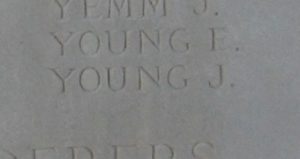Beaufort is a village and community located in the historic county of Breconshire. The settlement arose on the boundary of two parishes, Llangattock in Breconshire, and Aberystruth in Monmouthshire on the 1779 establishment of the Beaufort Iron Works by Edward and Jonathan Kendall, after whom the new settlement was first named. The village’s name derives from the fact that much of the local land was originally owned by the Duke of Beaufort. The border between Beaufort and Ebbw Vale itself is generally considered to be the Ebbw River which passes close to St David’s Church. Beaufort was transferred to the county of Monmouthshire in 1888, but for many years afterwards was referred to as Beaufort, Breconshire. The men of Beaufort, and neighbouring Rassau, who fell during all wars are commemorated on a modern war memorial, which is situated in Bethesda Church Memorial Garden, at Beaufort Rise, Beaufort. The memorial has no names as it was felt that it would be too easy to miss out people, which is understandable. However, there are several war memorials locally which do commemorate the fallen by name.
This webpage commemorates the men and one woman named on the war memorial which is located inside St. David’s Church, in Beaufort. The memorial takes the form of an engraved marble plaque which hangs inside the Church, which commemorates its parishioners who fell during the Great War. There is a similarly styled memorial for the fallen of the Second World War, but unfortunately, I do not currently have a photograph of this, so cannot add it to the website.
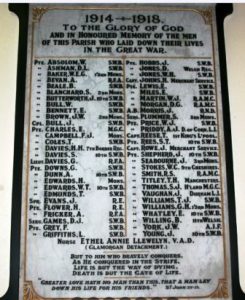
The Great War, 1914-1918
William Henry Absalom, Sapper, 108135, Royal Engineers. William was born in 1883, the son of Henry Absalom and Elizabeth Absalom (nee Love), of 16, Pontrhydyfen Terrace, Llanfrechfa. His father died in 1889 and his mother remarried to Charles Thornton. William was then raised with his stepfather at School Road, Rassau. He worked as a carpenter prior to enlisting at Abergavenny into the Royal Engineers on 8 July 1915. William was drafted to France on 30 January 1916 and upon disembarking was posted to the 215th Army Troops Company, Royal Engineers. He served on the Western Front until the end of the war, when he returned to the RE Depot at Chatham for demobilisation. William returned home to Beaufort and went to live at Vine Cottage, Rassau, where his stepfather and mother then lived. He contracted pneumonia not long after being discharged from the army and died at Vine Cottage on 28 October 1919, aged 37. Nothing further is known of William as he is not commemorated by the CWGC. He is buried in St. David’s Churchyard, Beaufort.
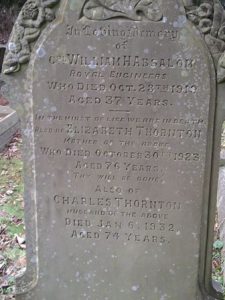
David Linton Ashman, Private, 32226, South Wales Borderers. David was the son of David John Ashman and Mary Ashman (nee Jones), of 1, Cross Row, Rassau. He enlisted into the South Wales Borderers at Newport and was drafted to France in the Spring of 1916, joining the 10th Battalion, South Wales Borderers, which was attached to 115 Brigade, 38th (Welsh) Division. He joined the Division near Cuinchy before it marched south to the Somme sector in June 1916 to take part in the assault on Mametz Wood. The first attack on the wood was launched on a two-battalion front on 7 July, but failed, and the Divisional Commander, Sir Ivor Philipps, was replaced before the Division attacked again on a two Brigade front on 10 July 1916. After two days of ferocious hand-to-hand fighting, the wood was cleared up to its northern edge, before the battered Division was relieved. It then took over a section of the front at Hébuterne before moving to the Ypres Salient and taking over the Canal Bank sector at Boesinghe. The infantry battalions of the Division then began carrying out the normal pattern of rotation in the trenches, four days in the front, four in support and four in reserve, whilst also working on trench improvement, digging new trenches, and carrying out regular patrols and trench raids. On 31 July 1917 the Division launched its famous assault on the Pilckem Ridge, capturing Iron Cross and reaching its objective of the Steenbeek, then played a supporting role in the Battle of Langemarck. The Division was transferred to the Sailly-sur-la-Lys sector in September and remained in the area over the winter before being moved to positions north of Albert, at Bouzincourt Ridge, at the end of March 1918, relieving the battered 2nd and 47th Divisions. It held this sector, again carrying out minor operations and trench raids, over the coming months, before taking part in the great offensive of 21 August 1918, and began its advance towards the Hindenburg Line. Over the coming weeks the division crossed the old Somme battlefields, recapturing Pozieres, Mametz Wood, Longueval, Delville Wood and Morval, before advancing across the Bapaume to Péronne Road and crossing the Canal du Nord. By 3 October the Division had reached Lempire, in the outer Hindenburg Defensive Line and on the following day began its attacks on the Hindenburg outposts. David was killed in action four days later, on 8 October 1918, during the Divisions assault on Villers-Outréaux. The 19-year-old is buried in Guizancourt Farm Cemetery, Gouy.
William Edward George Baker, Private, 2568, Monmouthshire Regiment. William was the son of William George Baker and Catherine Baker (nee Thornton), of 47, Harcourt Street, Ebbw Vale. He married Annie Jones in 1907 and the couple set up home at 43, Harcourt Street, Beaufort. William worked as a coal hewer prior to enlisting into the 3rd Battalion, Monmouthshire Regiment at Abergavenny. The battalion was mobilized at Abergavenny on 4 August 1914 attached to the Welsh Border Brigade, Welsh Division, before moving to Pembroke Dock. The Division then moved to Oswestry before moving to Northampton at the end of August. The Division moved to Bury St. Edmunds in December then in January 1915 moved to Cambridge, then in February 1915 the 3rd Monmouth’s left the Welsh Division and landed in France on 14 February 1915. Two weeks later the battalion joined 83 Brigade, 28th Division at Ypres. On 8 April the 3rd Monmouth’s relieved a French Division in the sector east of the Polygon Wood to begin its first tour in the trenches. The battalion was relieved four days later, and marched to billets in Ypres, then on 17 April relieved the 5th King’s Own in the front line, to begin a spell which would last for 17 days without relief. On 22 April, just to the north, the Germans launched the first gas attack of the war upon French Colonial troops at Gravenstafel, heralding the opening of the Second Battle of Ypres. The fighting remained to the north of Polygon Wood until 3 May, when the Germans widened their attacks and the Polygon Wood sector was evacuated by the 28th Division, which fell back on the G.H.Q. line at Potijze. Over the coming days their new positions were shelled mercilessly, then on 8 May the Germans attacked. Despite heavy losses the Division held firm and later that day three Companies of the 3rd Monmouth’s moved back into billets at Vlamertinghe, leaving B Company in the line. By now casualties had become so severe that on 10 May a Composite Battalion was formed from remnants of 83 Brigade, under Lt Col Gough, and proceeded to the G.H.Q. line at Potijze. William was killed in action here during the following day, 11 May 1915. The 31-year-old has no known grave and is commemorated on the Ypres (Menin Gate) Memorial, Belgium.
Albert Edward Beale, Private, 57920, Royal Welsh Fusiliers. Albert was born at Castle Morton, Herefordshire in 1891, the son of Edward Beale and Mary Beale. By 1911 he was lodging at 11, Wesley Place, Beaufort, where he worked as a coalminer. He married Lucy Louisa Savage at Beaufort in 1913, and the couple had a son, Ronald Albert Beale, born there the following year, at 9, Primitive Place, Beaufort. Albert enlisted into the Training Reserve at Abertillery and was initially posted to the Welsh Regiment. He was drafted to France in the winter of 1917-18, and was transferred to the 9th Battalion, Royal Welsh Fusiliers, which was attached to 58 Brigade, 19th (Western) Division. The Division wintered in the Cambrai sector, following the closure of the Battle of Cambrai, and was holding a section of the line in the Flesquières Salient. On 21 March 1918 the Germans launched the first of three offensives on to the section of the front running from Flesquières to St. Quentin, and the 19th Division was thrown into desperate fighting as it was pushed back over the coming days. The battered Division was then moved to the Messines sector to rest, but on 11 April became caught up in the second phase of the German offensive, which had been launched along the Lys Valley on 9 April, and again became caught up in desperate fighting. The remnants of the Division were moved south to the Aisne sector to rest and rebuild, but by sheer bad luck, the Germans third, and last, offensive was launched here on 27 May 1918, and the Division was once more caught up in desperate fighting. Albert appears to have been taken prisoner by the Germans at sometime afterwards. He died in captivity, in the Field Hospital at Aubenton on 3 November 1918. The 27-year-old was originally buried in Aubenton Communal Cemetery, but in June 1934 his grave was exhumed, and he was re-interred in Sissonne British Cemetery, France. Interestingly, the war memorial at St. David’s states that he served with the South Wales Borderers. In fact, his younger brother, Alfred Ernest Beale, served with the South Wales Borderers, so the memorial could commemorate either man?
Alfred Ernest Beale, Private, 48642, South Wales Borderers. Alfred was born at Castle Morton, Herefordshire in 1899, the son of Edward Beale and Mary Beale. He lived with his elder brother, Albert, at Beaufort prior to enlisting at Abertillery into the Training Reserve. Upon being drafted to France in the Spring of 1918, he was posted to the 10th Battalion, South Wales Borderers, which was attached to 115 Brigade, 38th (Welsh) Division. The Division had transferred to the Sailly-sur-la-Lys sector in September 1917 and remained in the area over the winter before being moved to positions north of Albert, at Bouzincourt Ridge, at the end of March 1918, relieving the battered 2nd and 47th Divisions. It held this sector, carrying out minor operations and trench raids, over the coming months. On 9 May 1918 the 10th SWB was at work near Bouzincourt, supplying working parties, when the Germans opened a savage artillery bombardment upon its positions. Alfred was killed in action here that day. The 19-year-old has no known grave and is commemorated on the Pozieres Memorial, France.
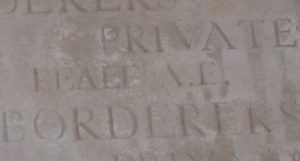
Ebenezer Bennett, Private, 20282, South Wales Borderers. Ebenezer was born at Beaufort in 1861, the son of Thomas and Ann Bennett. He married Elizabeth Nicholas in 1885 and the couple set up home at 30, South Street, Beaufort. Ebenezer worked as a coal hewer for many years prior to enlisting into the 10th Battalion, South Wales Borderers at Brecon soon after the outbreak of war. The battalion had been formed as one of two Gwent Battalions of the South Wales Borderers, especially to join the newly formed 43rd (Welsh) Division. Ebenezer had not been in uniform long when he took ill, and he died at Beaufort on 19 December 1914. The 51-year-old was buried in St. David’s Churchyard, Beaufort.
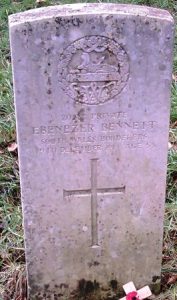
Bevan, A. Private, Royal Field Artillery. This man cannot presently be identified.
Stanley Blanchard, Private, 267429, Monmouthshire Regiment. Stanley was the son of Henry Blanchard and Martha Blanchard (nee Webb), of No 2, 4th Row, Newtown, Ebbw Vale. William lived with a sister, Edith Jane Thomas, at Timidyg Farm, Beaufort prior to enlisting into the Brecknockshire Battalion, South Wales Borderers on 19 October 1914 and was posted to the 2/1st Battalion, at Brecon. In April 1915 the battalion moved to Dale, on the Milford Haven defences, then at the end of 1915 moved to Bedford to join the 68th (2nd Welsh) Division. Stanley embarked for France on 30 July 1916 and was posted from the Infantry Base Depot at Rouen to the 2nd Battalion, Monmouthshire Regiment, which was by then the Pioneer Battalion to the 29th Division. The Division had suffered terrible casualties at Beaumont Hamel, during its assault on Y-Ravine on 1 July 1916 and, although severely depleted, the Division remained in the line here over the coming weeks, in trying conditions. On 27 July the Division entrained for Flanders, detraining at Proven before relieving the 6th Division at Ypres. The Division held the line here over the coming weeks as it rebuilt its strength and the 2nd Monmouth’s worked hard on improving trenches and digging new communications trenches. The battalion then worked on the Menin Road, erecting elephant shelters, then on 4 October the Division was relieved and entrained south for the Somme once more, moving to Trônes Wood, before joining the latter stages of the Somme offensive. The Division wintered on the Somme, with the 2nd Monmouth’s working on road repairs around Montauban, then at Ginchy, Flers and Morval. The 2nd Monmouth’s moved into reserve at the end of December and moved to Fourdrinoy, where the men trained in infantry assault manoeuvres. On 12 January 1917 the battalion began marching back into the battle area, taking over positions near Morval, and began supplying working parties around Montauban once more. At the beginning of April, the entire 29th Division moved out of the Somme sector to the Arras sector, and by 9 April took over a section of the line facing Monchy-le-Preux. The Division then began to prepare for the forthcoming Battle of Arras. At dawn on 23 April 1917, the Division launched an assault on Monchy-le-Preux. The 2nd Monmouth’s, following the infantry assault, began work on strong points near Wancourt, while some of the men were put to work on digging new communications trenches as the battle raged. Stanley was killed in action here at some time during the day. The 24-year-old was originally buried on the battlefield, but during the post-war battlefield clearances his remains were located and in January 1920 he was re-interred in Vis-En-Artois British Cemetery, Haucourt, France. His brother-in-law, William Dallimore, was killed in France in 1915.
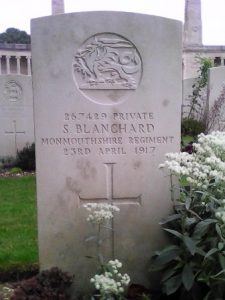
William James Brown, Private, 267818, Monmouthshire Regiment. William was the son of Margaret Brown, of 97, The Rise, Beaufort. He worked as an underground haulier prior to enlisting into the 3rd (Reserve) Battalion, Monmouthshire Regiment at Abergavenny on 19 October 1914. The battalion had formed at Abergavenny the previous month, then in February 1915 joined the Welsh Border Brigade, Welsh Division at Cambridge. In April 1915 the battalion joined 205 Brigade, 68th (2nd Welsh) Division at Northampton, before moving to Bedford in July. On 22 July 1916 William was drafted to France and was posted from the Infantry Base Depot to join the 2nd Battalion Monmouthshire Regiment, which by then was on the Somme attached to the 29th Division as the Divisional Pioneer Battalion. The Division had suffered terrible casualties at Beaumont Hamel, during its assault on Y-Ravine on 1 July 1916 and, although severely depleted, the Division remained in the line here over the coming weeks, in trying conditions. On 27 July the Division entrained for Flanders, detraining at Proven before relieving the 6th Division at Ypres. The Division held the line here over the coming weeks as it rebuilt its strength and the 2nd Monmouth’s worked hard on improving trenches and digging new communications trenches. The battalion then worked on the Menin Road, erecting elephant shelters, then on 4 October the Division was relieved and entrained south for the Somme once more, moving to Trônes Wood, before joining the latter stages of the Somme offensive. The Division wintered on the Somme, with the 2nd Monmouth’s working on road repairs around Montauban, then at Ginchy, Flers and Morval. The 2nd Monmouth’s moved into reserve at the end of December and moved to Fourdrinoy, where the men trained in infantry assault manoeuvres. On 12 January 1917 the battalion began marching back into the battle area, taking over positions near Morval, and began supplying working parties around Montauban once more. The Division then received orders to mount an attack, so at dawn on 27 January 1917 the 2nd Monmouth’s began work on two new communication trenches to connect the old front line to the new objectives. William was killed in action at some time during the day, probably due to artillery fire. The 27-year-old has no known grave and is commemorated on the Thiepval Memorial, France.
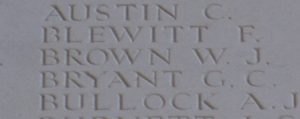
John Bull, Corporal, 20374, South Wales Borderers. John was the son of Joseph and Martha Bull, of 27, North Street, Beaufort Hill, Beaufort. He married Elizabeth Lavinia Freebury in 1902 and the couple set up home at 3, Cross Row, Rassau. John worked as a coal hewer for the Ebbw Vale Company prior to enlisting into the 11th South Wales Borderers at Ebbw Vale soon after the outbreak of war. The battalion was at Colwyn Bay attached to the 43rd (Welsh) Division. The Division trained in North Wales before moving to Winchester in the summer of 1915, where the formation became renumbered 113 Brigade, 38th (Welsh) Division. The Division began moving to France on 2 December 1915 and moved to the Nursery Sector near Fleurbaix for trench initiation alongside the Guards Division. The Division then held a sector of the line near Cuinchy before marching south to the Somme sector in June 1916 to take part in the assault on Mametz Wood. The first attack on the wood was launched on a two-battalion front on 7 July, but failed, and the Divisional Commander, Sir Ivor Philipps, was replaced before the Division attacked again on a two Brigade front on 10 July 1916. After two days of ferocious hand-to-hand fighting, the wood was cleared up to its northern edge, before the battered Division was relieved. It then took over a section of the front at Hébuterne before moving to the Ypres Salient and taking over the Canal Bank sector at Boesinghe. The infantry battalions of the Division then began carrying out the normal pattern of rotation in the trenches, four days in the front, four in support and four in reserve, whilst also working on trench improvement, digging new trenches, and carrying out regular patrols and trench raids. On 31 July 1917 the Division launched its famous assault on the Pilckem Ridge, capturing Iron Cross and reaching its objective of the Steenbeek. John was killed in action during the assault that day. The 37-year-old has no known grave and is commemorated on the Ypres (Menin Gate) Memorial, Belgium. His son, John Henry Bull, was killed at Antwerp during the Second World War.
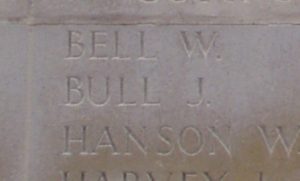
Worthy Bull, Private, 39838, South Wales Borderers. Worthy was the only son of Henry Bull and Kate Adelaide Bull (nee Bedford), of Clynderwen House, Beaufort. He worked as a shop assistant prior to enlisting into the Monmouthshire Regiment at Abertillery soon after the outbreak of war. Upon being drafted to France in the Spring of 1917, Worthy was transferred to the 2nd Battalion, South Wales Borderers, which was at Arras attached to 87 Brigade, 29th Division. In the Spring of 1917, the Division fought at the Battle of the Scarpe, which was part of the Arras Offensive, seeing heavy fighting around Monchy-le-Preux, and then moved further north to Ypres, initially to hold the line whilst other units had been withdrawn for specialist training, in readiness for the Third Battle of Ypres, which opened on 31 July 1917. The 29th Division went into reserve whilst the first attacks, the Battle of Pilckem Ridge, took place, then on the night of 14-15 August the 2nd SWB moved into the line facing Langemarck, ready to launch another offensive. On the following day the battalion reconnoitred the ground in front of them, and laid white tapes in No Man’s Land, to guide the attacking troops, and at dawn on 16 August 1917 the 2nd SWB launched an attack on Langemarck. The battalion successfully took its two objectives but had suffered 163 casualties. The Division then had another period out of the line to rest and refit before taking part in further fighting near Poelcapelle. Early in October 1917 the Division was relieved from the line at Ypres, and moved south to the Bellacourt area, to prepare to take part in the forthcoming Battle of Cambrai. The Division entrained for Péronne on 17 November, marching to a camp four miles out of the town at Haut Allaines, then by midnight on 18 November had reached Fins. On the following day the Division received its battle stores and detailed orders for the forthcoming battle, marching off via Gouzeaucourt to its assembly positions at Marcoing. The assault began at dawn on 20 November, but the Division suffered terrible casualties whilst attacking Masnières, on the Hindenburg Line. After wintering in the Cambrai sector, in January 1918 the 29th Division moved back to Ypres, taking up positions at Passchendaele Ridge again. To the south, the Germans launched the opening phase of their great offensive along the Somme front on 21 March 1918, then on 9 April launched the second phase along the Lys Valley. The 29th Division was relieved by the 41st Division that day and moved out of the line, before being rushed to positions at Les Haies Basses on the evening of 10 April. On the following morning the Division was hit by the Germans and the 29th Division was forced to withdraw, as they were flanked on the left. Worthy was killed in action during the fighting that day. The 25-year-old has no known grave and is commemorated on the Ploegsteert Memorial, Belgium.
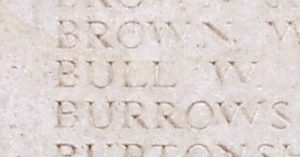
John Butterworth, Private, 20318, South Wales Borderers. John was born at Stalybridge, in Cheshire. He married Sarah Jane Kelsey in Cheshire in 1906 and at some time after 1911 the couple had moved to Beaufort, with their two children. John enlisted at Ebbw Vale into the 10th Battalion, South Wales Borderers soon after the outbreak of war. The battalion was at Colwyn Bay attached to the 43rd (Welsh) Division. The Division trained in North Wales before moving to Winchester in the summer of 1915, where the formation became renumbered 113 Brigade, 38th (Welsh) Division. The Division began moving to France on 2 December 1915 and moved to the Nursery Sector near Fleurbaix for trench initiation alongside the Guards Division. The Division then held a sector of the line near Cuinchy before marching south to the Somme sector in June 1916 to take part in the assault on Mametz Wood. The first attack on the wood was launched on a two-battalion front on 7 July, but failed, and the Divisional Commander, Sir Ivor Philipps, was replaced before the Division attacked again on a two Brigade front on 10 July 1916. After two days of ferocious hand-to-hand fighting, the wood was cleared up to its northern edge, before the battered Division was relieved. It then took over a section of the front at Hébuterne before moving to the Ypres Salient and taking over the Canal Bank sector at Boesinghe. The infantry battalions of the Division then began carrying out the normal pattern of rotation in the trenches, four days in the front, four in support and four in reserve, whilst also working on trench improvement, digging new trenches, and carrying out regular patrols and trench raids. On 31 July 1917 the Division launched its famous assault on the Pilckem Ridge, capturing Iron Cross and reaching its objective of the Steenbeek, then played a supporting role in the Battle of Langemarck. The Division was transferred to the Sailly-sur-la-Lys sector in September and remained in the area over the winter before being moved to positions north of Albert, at Bouzincourt Ridge, at the end of March 1918, relieving the battered 2nd and 47th Divisions. It held this sector, again carrying out minor operations and trench raids, over the coming months, before taking part in the great offensive of 21 August 1918, and began its advance towards the Hindenburg Line. John was taken ill during the great advance and was evacuated back to England, before being taken to the Brook War Hospital at Woolwich. He died there of pneumonia on 22 October 1918. The remains of the 33-year-old were taken home and he was buried in St. Paul’s Churchyard, Stalybridge. The family moved to Rhyl after John’s death.
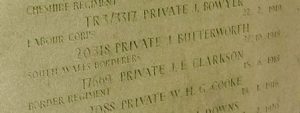
Frederick John Campbell, Private, 33768, Yorkshire Regiment. Frederick was the son of Police Constable Frederick Campbell and Elizabeth Campbell (nee Williams), of 67, The Uplands, Rogerstone. He lived in Beaufort prior to enlisting at Ebbw Vale into the Army Service Corps, but was then transferred to the infantry, first joining the Essex Regiment. Upon being drafted to France in the summer of 1917, Frederick was transferred to the 5th Battalion, Yorkshire Regiment. The battalion was attached to 150 Brigade, 50th (Northumbrian) Division and was rebuilding following heavy losses during the Arras Offensive of April and May. The Division moved to Ypres in October and took part in the Second Battle of Passchendaele, before wintering at Ypres. At the end of February 1918, the Division was relieved and moved into reserve, before being transferred to Demuin, in the St. Quentin Sector. The Germans launched the first phase of the Spring offensive along a stretch of the Western Front running south from Croisilles to La Fère on 21 March 1918 and the 50th Division was ordered forward into the line to help bolster the thinly stretched defences at Vraignes. The Division then took part in a gallant rear-guard action during the Actions at the Somme Crossings, and then at the Battle of Rosieres. After suffering terrible casualties, the Division moved north to Flanders to rest and rebuild, but on 9 April the Germans launched the second phase of their attack in Flanders, around the Lys Valley, and the Division was again caught up in desperate fighting before being relieved and moved south to join IX Corps on the Aisne, believed to be a much quieter area. This was unfortunately not the case, as the Division was hit hard by the third phase of the German attack here on 27 May 1918. The 5th Yorkshire’s were in the line when the Germans attacked, and the battalion was virtually annihilated. Frederick was 20 years old when he was killed in action during the fighting that day. He is buried in Vendresse British Cemetery, France.
Edgar Charles, Private, 88429, Machine Gun Corps. Edgar was the son of Edmund Charles and Jane Charles (nee Prosser), of Cwm Gwibedog, Beaufort. He worked as a building contractor at Beaufort prior to enlisting into the 4th (Reserve) Battalion, Welsh Regiment at Ebbw Vale on 25 February 1916 and was initially placed on the Army Reserve. Edgar was mobilised on 1 January 1917 and joined the battalion at Pembroke where he completed his training and was transferred to the Machine Gun Corps before being drafted to France on 6 May 1917, joining the 98th Company, Machine Gun Corps on 30 May. The Company was at Beuvry, attached to 98 Brigade, 33rd Division and was Stood To, ready to move at two hours’ notice when Edgar arrived. The Division was holding the Fontaine-les-Croisilles Sector, but at the end of June moved out of the sector into the Somme back areas, near Airaines, where it spent almost a month before taking over front-line positions on the Channel coast, near Bray Dunes, in the Nieuwpoort Sector. The intention was for the Division to launch an assault along the coast but following the failure of the army to break out at Ypres, the Division was rushed to the city, before taking over positions facing Polygon Wood by 25 September, joining the Passchendaele offensive. Over the coming days the Division saw terrible fighting for the wood, before being relieved, and moved to the Messines Sector the following month. Edgar was wounded at Messines soon after arriving and was evacuated to the 1st Canadian General Hospital at Étaples, where he died of his wounds on 1 November 1917. The 27-year-old is buried in Étaples Military Cemetery, France.
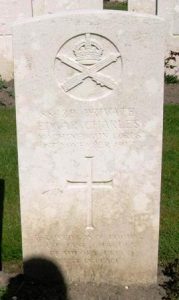
Thomas Coles, Private, 15352, South Wales Borderers. Thomas was the son of Thomas Coles and Mary Coles (nee Williams), of New Church Row, Aberystwyth. He had served with the South Wales Borderers for several years as a young man, after enlisting into the regiment at Brecon on 22 August 1893, and after leaving the army lived at Garn Row, Beaufort where he worked as a collier. Thomas then re-enlisted into the South Wales Borderers soon after the outbreak of war. He was initially stationed at Brecon until being posted to the 2nd Battalion, South Wales Borderers in January 1915. The battalion had just returned to England following service in China and had landed at Plymouth on 12 January 1915, entraining for Rugby to join 87 Brigade, 29th Division. On 17 March 1915 the battalion sailed from Avonmouth with the Division, arriving at Alexandria on 29 March, before moving to Mudros. On 25 April 1915 the Division landed at Cape Helles, Gallipoli, as part of the original landing force which had been despatched to try and seize the Dardanelles Straits and force Turkey out of the war. The invasion forces failed to break the Turkish defences and the campaign became bogged down. Thomas was killed in action near Gully Ravine on 19 June 1915. The 40-year-old has no known grave and is commemorated on the Helles Memorial, Gallipoli.

Graham Davies, Lieutenant, Royal Field Artillery. Graham was the son of William and Harriette Davies, of Minafon, Beaufort. He worked as an underground coal measurer prior to enlisting into the Welsh Divisional Royal Field Artillery in November 1914 and was posted to North Wales, where he was commissioned as Second Lieutenant, joining A Battery, 121st Brigade, Royal Field Artillery, which was a unit of the 38th (Welsh) Division. The Division began moving to France on 2 December 1915 and moved to the Nursery Sector near Fleurbaix for trench initiation alongside the Guards Division. The Division then held a sector of the line near Cuinchy before marching south to the Somme sector in June 1916 to take part in the assault on Mametz Wood. The first attack on the wood was launched on a two-battalion front on 7 July, but failed, and the Divisional Commander, Sir Ivor Philipps, was replaced before the Division attacked again on a two Brigade front on 10 July 1916. After two days of ferocious hand-to-hand fighting, the wood was cleared up to its northern edge, before the battered Division was relieved. It then took over a section of the front at Hébuterne before moving to the Ypres Salient and taking over the Canal Bank sector at Boesinghe. The infantry battalions of the Division then began carrying out the normal pattern of rotation in the trenches, four days in the front, four in support and four in reserve, whilst also working on trench improvement, digging new trenches, and carrying out regular patrols and trench raids. As the summer of 1917 dawned, the Division began preparing for the forthcoming Passchendaele offensive, being tasked with the capture of Pilckem Ridge. Graham was badly wounded during the build up to the offensive and died of his wounds on 27 July 1917. The 28-year-old was buried in Canada Farm Cemetery, Belgium.
Howell Henry Davies, Private, 213880, Border Regiment. Howell was the son of William Davies and Mercy Davies (nee Luff), of Rose Cottage, Beaufort Hill, Beaufort. He married Mary Harriett Withers, of 226, King Street, Brynmawr in 1913 and the couple set up home at 8, North Street, Beaufort hill, where Howell worked as a coal hewer. Howell enlisted into the Brecknockshire Battalion, South Wales Borderers at Brynmawr soon after the outbreak of war. Howell spent much of the war on home service and was posted to the Royal Defence Corps for a while before being drafted to France in the Spring of 1918 and was transferred to the 7th (Westmorland and Cumberland Yeomanry) Battalion, Border Regiment. The battalion was attached to 51 Brigade, 17th Division and had suffered heavy losses during the opening phase of the German Spring offensive in March 1918, when the Division took part in a gallant rear-guard action, withdrawing from Moeuvres towards Millencourt. After a period out of the line to rest and rebuild, the Division moved to the southernmost sector of the Somme area, where it fought at the Battle of Amiens on 8 August 1918, a day which saw the war swing in the favour of the Allies. The Allies then advanced on the Somme from 21 August, and the Division took part in this great offensive, driving towards the Hindenburg Line over the coming weeks, fighting at the Battle of Havrincourt on 12 September and the Battle of Épehy on 18 September. At the beginning of October, the mighty Hindenburg Line was broken, and the 17th Division swept towards Cambrai, fighting at the Battle of Cambrai on 8 October, and then continued to advance north-east through northern France, towards the old Battlefields of Mons and Le Cateau. On 19 October the 7th Border Regiment left Montigny to take up assembly positions prior to launching the next phase of their advance. At dawn on 20 October 1918 the battalion launched an assault against the Germans across the River Selle but became counter-attacked and in turn counter-attacked themselves. Howell was killed in action during the fighting that day. The 24-year-old is buried in Amerval Communal Cemetery Extension, Solesmes, France.
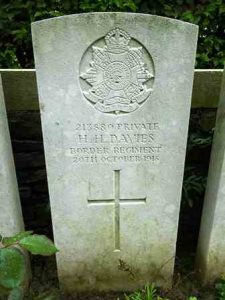
Stanley Davies, Lance Corporal, 20241, South Wales Borderers. Stanley was the son of Lewis Davies and Desdemona Davies (nee Phillips), of 5, Railway View, Beaufort. He worked as a coal hewer prior to enlisting into the 10th Battalion, South Wales Borderers at Ebbw Vale soon after the outbreak of war. The battalion was at Colwyn Bay attached to the 43rd (Welsh) Division. The Division trained in North Wales before moving to Winchester in the summer of 1915, where the formation became renumbered 113 Brigade, 38th (Welsh) Division. The Division began moving to France on 2 December 1915 and moved to the Nursery Sector near Fleurbaix for trench initiation alongside the Guards Division. The Division then held a sector of the line near Cuinchy before marching south to the Somme sector in June 1916 to take part in the assault on Mametz Wood. The first attack on the wood was launched on a two-battalion front on 7 July, but failed, and the Divisional Commander, Sir Ivor Philipps, was replaced before the Division attacked again on a two Brigade front on 10 July 1916. After two days of ferocious hand-to-hand fighting, the wood was cleared up to its northern edge, before the battered Division was relieved. It then took over a section of the front at Hébuterne before moving to the Ypres Salient and taking over the Canal Bank sector at Boesinghe. The infantry battalions of the Division then began carrying out the normal pattern of rotation in the trenches, four days in the front, four in support and four in reserve, whilst also working on trench improvement, digging new trenches, and carrying out regular patrols and trench raids. On 31 July 1917 the Division launched its famous assault on the Pilckem Ridge, capturing Iron Cross and reaching its objective of the Steenbeek, then played a supporting role in the Battle of Langemarck. The Division was transferred to the Sailly-sur-la-Lys sector in September and remained in the area over the winter before being moved to positions north of Albert, at Bouzincourt Ridge, at the end of March 1918, relieving the battered 2nd and 47th Divisions. It held this sector, again carrying out minor operations and trench raids, over the coming months. On 6 June the 10th SWB took over the front line in the Mesnil Sector, to begin a routine tour in the trenches. Stanley was killed in action here just before the battalion was relieved on 11 June 1918. The 23-year-old is buried in Engelbelmer Communal Cemetery Extension, France.
Gwillym Downs, Private, 20280, South Wales Borderers. Gwillym was the son of Edward James Downs and Margaret Downs (nee Hopkins), of 15, Beaufort Terrace, Beaufort. He lived at 8, Shop Row, Beaufort prior to the war and worked as a haulier above ground. Gwillym enlisted into the 10th Battalion, South Wales Borderers at Ebbw Vale soon after the outbreak of war. The battalion was at Colwyn Bay attached to the 43rd (Welsh) Division. The Division trained in North Wales before moving to Winchester in the summer of 1915, where the formation became renumbered 113 Brigade, 38th (Welsh) Division. The Division began moving to France on 2 December 1915 and moved to the Nursery Sector near Fleurbaix for trench initiation alongside the Guards Division. The Division then held a sector of the line near Cuinchy before marching south to the Somme sector in June 1916 to take part in the assault on Mametz Wood. The first attack on the wood was launched on a two-battalion front on 7 July, but failed, and the Divisional Commander, Sir Ivor Philipps, was replaced before the Division attacked again on a two Brigade front on 10 July 1916. After two days of ferocious hand-to-hand fighting, the wood was cleared up to its northern edge, before the battered Division was relieved. It then took over a section of the front at Hébuterne before moving to the Ypres Salient and taking over the Canal Bank sector at Boesinghe. The infantry battalions of the Division then began carrying out the normal pattern of rotation in the trenches, four days in the front, four in support and four in reserve, whilst also working on trench improvement, digging new trenches, and carrying out regular patrols and trench raids. Gwillym is shown in all surviving the records as having been killed in action on 28 June 1917. Both the 10th and 11th SWB were out of the line, training in readiness for the forthcoming assault on Pilckem Ridge during that period, so how he was killed is a mystery. The 41-year-old is buried in Bard Cottage Cemetery, Belgium.
Albert Dunn, Private, 20380, South Wales Borderers. Albert was the son of William and Mary Dunn, of 2, Mount Pleasant Square, Bedwellty. He married Mary Jane Thomas in 1902 and the couple set up home at 2, Cross Row, Rassau. Albert worked as a coal hewer prior to enlisting into the 10th Battalion, South Wales Borderers at Ebbw Vale soon after the outbreak of war. The battalion was at Colwyn Bay attached to the 43rd (Welsh) Division. The Division trained in North Wales before moving to Winchester in the summer of 1915, where the formation became renumbered 113 Brigade, 38th (Welsh) Division. The Division began moving to France on 2 December 1915 and moved to the Nursery Sector near Fleurbaix for trench initiation alongside the Guards Division. The Division then held a sector of the line near Cuinchy before marching south to the Somme sector in June 1916 to take part in the assault on Mametz Wood. The first attack on the wood was launched on a two-battalion front on 7 July, but failed, and the Divisional Commander, Sir Ivor Philipps, was replaced before the Division attacked again on a two Brigade front on 10 July 1916. After two days of ferocious hand-to-hand fighting, the wood was cleared up to its northern edge, before the battered Division was relieved. It then took over a section of the front at Hébuterne before moving to the Ypres Salient and taking over the Canal Bank sector at Boesinghe. The infantry battalions of the Division then began carrying out the normal pattern of rotation in the trenches, four days in the front, four in support and four in reserve, whilst also working on trench improvement, digging new trenches, and carrying out regular patrols and trench raids. On 31 July 1917 the Division launched its famous assault on the Pilckem Ridge, capturing Iron Cross and reaching its objective of the Steenbeek, then played a supporting role in the Battle of Langemarck. Albert was badly wounded at Langemarck and was evacuated to a Casualty Clearing Station at Proven, where he died of his wounds on 17 August 1917. The 34-year-old was buried in Dozinghem Military Cemetery, Belgium.
Henry Edwards, Private, 288012, Royal Engineers. Henry was the son of John Phillip Edwards and Sarah Ann Edwards, of 6, Libanus Road, Ebbw Vale. He married Harriett Baker on 25 December 1912 and the couple set up home at 21, Gantra Place, Beaufort. Henry worked as a coal hewer prior to enlisting into the 3rd (Reserve) Battalion, Monmouthshire Regiment at Abergavenny on 20 October 1914. He remained on home service for over two years before embarking for France on 21 December 1916 and was posted from the Infantry Base Depot at Rouen to the 2nd Battalion, Monmouthshire Regiment on 5 January 1917. Upon joining the battalion, which was the Pioneer Battalion to the 29th Division, Henry was attached to the 180th Tunnelling Company, Royal Engineers. The Company was on the Somme, as was the 29th Division, and was hard at work on the Martinpuich Defences. The 180th TC then began work on the Assevillers Defences, before beginning work repairing roads and filling in several captured German dug outs and pits. Henry was wounded near Assevillers on 4 March 1917 and was evacuated to the 48th Casualty Clearing Station, suffering from gunshot wounds to his head, back and hip. He died of his wounds there two days later, on 6 March 1917. The 25-year-old is buried in Bray Military Cemetery, France.
John Thomas Edwards, Sergeant, 39059, South Wales Borderers. John was born at Tipton, Staffordshire on 27 July 1889, the son of Joseph Edwards and Elizabeth Edwards. John and his brother Joseph moved to Brynmawr as young men to find work as coalminers. John married Eliza Davies on 12 February 1912 and the couple set up home at Eagle Cottage, Beaufort Hill, Beaufort. John enlisted at Brynmawr into the South Wales Borderers and was drafted to France in the Spring of 1917, joining the 1st Battalion, South Wales Borderers, which was attached to 3 Brigade, 1st Division. The Division had followed the German retreat to the Hindenburg Line in early 1917 and was then briefed for an operation on the Flanders Coast, being relieved at the end of May 1917 and by the middle of June had taken over their new positions on the coast. While the Division was holding the line near Coxyde, the Passchendaele offensive was launched on 31 July 1917, but had got bogged down, so at the beginning of November the Division was transferred to Ypres, to join the great push for Passchendaele Ridge. The Division took up positions near Valour Farm, on the lower edge of the ridge, by 9 November and prepared to launch an assault on the following morning. The objectives were a series of ruined farms which had been fortified by the Germans and at dawn on 10 November 1917 the Division launched its assault. The men arose from the trenches and began to advance through thick mud, but the men got caught up in their own artillery barrage. John was killed in action at some time during the day. The 28-year-old has no known grave and is commemorated on the Tyne Cot Memorial, Belgium.
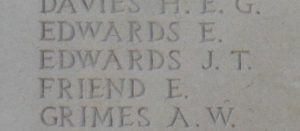
William Thomas Edwards, Private, 20315, South Wales Borderers. William was born at Brilly, Herefordshire in 1883, the son of William Edwards. He had moved to Rhymney to work as a coalminer by 1910 and on 3 December 1910 married Elizabeth Anne Bevan, at Rhymney. The couple then set up home at Samuel’s Row, Rassau. William enlisted into the 5th Battalion, South Wales Borderers at Brynmawr on 6 October 1914, but was discharged as medically unfit two weeks later. Undeterred, he re-enlisted into the South Wales Borderers at Ebbw Vale soon afterwards and was posted to Colwyn Bay to join the 10th Battalion, South Wales Borderers, which was attached to the 43rd (Welsh) Division. The Division trained in North Wales before moving to Winchester in the summer of 1915, where the formation became renumbered 113 Brigade, 38th (Welsh) Division. The Division began moving to France on 2 December 1915 and moved to the Nursery Sector near Fleurbaix for trench initiation alongside the Guards Division. The Division then held a sector of the line near Cuinchy before marching south to the Somme sector in June 1916 to take part in the assault on Mametz Wood. The first attack on the wood was launched on a two-battalion front on 7 July, but failed, and the Divisional Commander, Sir Ivor Philipps, was replaced before the Division attacked again on a two Brigade front on 10 July 1916. After two days of ferocious hand-to-hand fighting, the wood was cleared up to its northern edge, before the battered Division was relieved. It then took over a section of the front at Hébuterne before moving to the Ypres Salient and taking over the Canal Bank sector at Boesinghe. The infantry battalions of the Division then began carrying out the normal pattern of rotation in the trenches, four days in the front, four in support and four in reserve, whilst also working on trench improvement, digging new trenches, and carrying out regular patrols and trench raids. On 31 July 1917 the Division launched its famous assault on the Pilckem Ridge, capturing Iron Cross and reaching its objective of the Steenbeek, then played a supporting role in the Battle of Langemarck. The Division was transferred to the Sailly-sur-la-Lys sector in September and remained in the area over the winter before being moved to positions north of Albert, at Bouzincourt Ridge, at the end of March 1918, relieving the battered 2nd and 47th Divisions. It held this sector, again carrying out minor operations and trench raids, over the coming months, before taking part in the great offensive of 21 August 1918, and began its advance towards the Hindenburg Line. Over the coming weeks the division crossed the old Somme battlefields, recapturing Pozieres, Mametz Wood, Longueval, Delville Wood and Morval, before advancing across the Bapaume to Péronne Road and crossing the Canal du Nord. By 3 October the Division had reached Lempire, in the outer Hindenburg Defensive Line and on the following day began its attacks on the Hindenburg outposts. William was killed in action four days later, on 8 October 1918, during the Divisions assault on Villers-Outréaux. The 35-year-old was buried in Guizancourt Farm Cemetery, Gouy, France.
Jenkin Evans, Sapper, 156545, Royal Engineers. Jenkin was born at Brynmawr in around 1861. He came to Beaufort to find work as a collier and married Sarah Ann Evans there on 29 August 1894. The couple set up home at 55, Beaufort Hill, Beaufort, where they had at least eight children over the coming years. Jenkin enlisted at Ebbw Vale into the 10th Battalion, South Wales Borderers on 16 November 1914. The battalion was at Colwyn Bay attached to the 43rd (Welsh) Division. The Division trained in North Wales before moving to Winchester in the summer of 1915, where the formation became renumbered 113 Brigade, 38th (Welsh) Division. The Division began moving to France on 2 December 1915 and moved to the Nursery Sector near Fleurbaix for trench initiation alongside the Guards Division. On 1 June 1916 Jenkin transferred to the 254th Tunnelling Company, Royal Engineers. The company had been formed in England in 1915 and had served at Gallipoli that year. It was then moved to France and relieved the 176th Tunnelling Company in the northern Givenchy area in Spring 1916. Jenkin was therefore serving with the 254th Company when Sapper William Hackett, of the same unit, won the Victoria Cross whilst attempting to save Private Thomas Collins, of the 14th Welsh, when he was trapped underground at Givenchy on 22 June 1916. Both Hackett and Collins were killed and still lie beneath the fields there. The Company served under the Fourth Army from September 1916, moving to Ypres to begin work in preparation for the forthcoming Passchendaele offensive. Jenkin was killed whilst at work in the Ypres Salient on 12 July 1917. Sadly, the war diary for the company for that month is missing. The 56-year-old is buried in Poperinghe New Military Cemetery, Belgium.
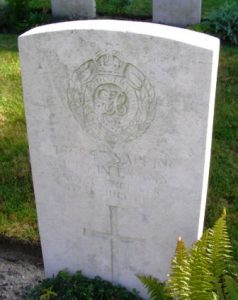
Henry Flower, Sapper, 111611, Royal Engineers. Henry was born in Pontypool in 1868, the son of Albert Flower and Rachel Flower (nee Davies). His father died when he was young, so Henry became the main breadwinner for the family, who resided at 6, Waterfall Row, Bedwellty. He married Elizabeth Cummings at Bedwellty Registry Office on 6 August 1912 and the couple initially set up home at 3, Gantra, Ebbw Vale. Henry enlisted into the Royal Engineers in Cardiff on 12 August 1915 and after completing his training, embarked for France on 22 August 1915. He served on the Western Front with a Labour Battalion for almost a year before his health began to fail, and after being diagnosed as suffering from tuberculosis, was sent back to Britain for treatment at the Royal Hospital, Chelsea. Henry was discharged from the army on 9 January 1917 and returned home to his wife at Ebbw Vale. Henry’s health continued to deteriorate, and he died of tuberculosis of the hip on 2 January 1919, aged 51. He has today, Saturday 17 December 2022, been accepted for commemoration by the CWGC, who will commemorate him in the United Kingdom Book of Remembrance at Maidenhead, unless the location of his grave can be located.
Albert George Fricker, Lance Bombardier, 29788, Royal Field Artillery. Albert was born at Radstock, Somerset on 16 March 1881, the son of George Fricker and Eliza Fricker. He had served with the Royal Field Artillery as a young man, and whilst based in The Barracks, Owlerton, Yorkshire, married Sarah Ellen Ashford on 26 February 1905. Albert then left the forces and the couple moved to 125, Beaufort Hill, Beaufort, where Albert had found work as a coal hewer. Following the outbreak of war, he re-enlisted at Brynmawr into the Royal Field Artillery. He originally embarked for the Middle East on 29 July 1915, probably serving at Gallipoli, but at some time afterwards was transferred to A Battery, 113th Brigade, Royal Field Artillery, which was in France. Albert was killed in action near Ypres on 4 October 1918. The 36-year-old is buried in Dadizeele New British Cemetery, Belgium.
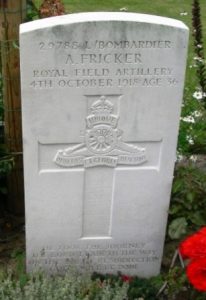
David John Games, Private, 36756, Northumberland Fusiliers. David was born on 12 April 1886, the son of David and Mary Catherine Games, of Woodland Cottage, Tretower. On 24 October 1905 he began work as an engine cleaner for the Great Western Railway at Aberbeeg Station, but by 1911 he was lodging at 10, Caroline Street, Llanelli, where he worked as an electrical linesman. David was living at Newport when war broke out and married Elsie May Sawtell there on 1 March 1916. He enlisted at Crickhowell into the army and upon being drafted to France was posted to the 24th Battalion, Northumberland Fusiliers, which was attached to 103 Brigade, 34th Division. The Division saw its first major action on the Somme on 1 July 1916, where it suffered very severe casualties during its part in the attack on La Boiselle. It then took part in the Battle of Bazentin Ridge and in the ensuing Battle of Pozieres and the Battle of Flers-Courcelette. The following year saw the Division move north to the Arras Sector where it took part in the First and Second Battles of the Scarpe, and then in the Battle of Arleux. On 10 August 1917 the 24th Battalion, Northumberland Fusiliers amalgamated with the 27th Battalion to form the 24/27th Battalion, Northumberland Fusiliers, in the same 34th Division. By now the Division was holding the line near Hargicourt. The 24/27th Battalion then began to rotate for duty in the front line, usually spending four days in the line, four in support, and four in reserve. At the end of September, the Division was relieved and moved to Proven, in the Ypres Salient, before taking over positions near Poelcapelle, to join the great push to capture the Passchendaele Ridge. David was killed in action when the battalion supported an attack by the 18th Division near Poelcapelle on 23 October 1917. The 31-year-old has no known grave and is commemorated on the Tyne Cot Memorial, Belgium.
Frederick Gray, Private, 12054, South Wales Borderers. Frederick was born at Ebbw Vale in 1889, the son of George Gray and Louisa Gray (nee Brimble). By 1911 George was living with his widowed mother at 22, Pond Row, Ebbw Vale, where he worked as a coal miner. He married Mary Ann Tunley, of Beaufort, in 1913. Frederick enlisted at Brynmawr into the 3rd Battalion, South Wales Borderers soon after the outbreak of war. He died not embark for France until some time in 1916, when he joined the 2nd Battalion, South Wales Borderers, which was attached to 87 Brigade, 29th Division. The Division had an arduous time during a suicidal assault on 1 July 1916, on the opening day of the Somme offensive. The 2nd SWB alone suffered some 384 casualties on that day alone. Although severely depleted, the Division remained in the line here over the coming weeks, in trying conditions. The Division was then pulled out of the line to rest and rebuild before moving back into the line and taking part in the latter stages of the Somme offensive. The Division wintered on the Somme, taking part in the advance which followed the German withdrawal to the Hindenburg Line. At the beginning of April, the entire 29th Division moved out of the Somme sector to the Arras sector, and by 9 April took over a section of the line facing Monchy-le-Preux. The Division then began to prepare for the forthcoming Battle of Arras. At dawn on 23 April 1917, the Division launched an assault on Monchy-le-Preux. The 2nd SWB captured the front-line German trench and advanced some 300 yards beyond before consolidating its gains. Frederick was killed in action at some time during the day. The 28-year-old has no known grave and is commemorated on the Arras Memorial, France. His widow, Mary Ann, married Ivor Beynon after Frederick’s death. Their son, also named Ivor Beynon, was killed in Burma in 1944.
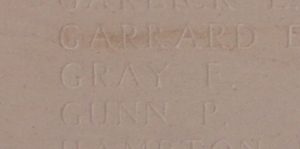
Lewis Griffiths, Private, 21290, South Wales Borderers. Lewis was the son of Walter and Mary Griffiths, of 4, Llangynidr Road, Beaufort. He worked as a coal miner prior to enlisting into the 10th Battalion, South Wales Borderers at Ebbw Vale soon after the outbreak of war. The battalion was at Colwyn Bay attached to the 43rd (Welsh) Division. The Division trained in North Wales before moving to Winchester in the summer of 1915, where the formation became renumbered 113 Brigade, 38th (Welsh) Division. The Division began moving to France on 2 December 1915 and moved to the Nursery Sector near Fleurbaix for trench initiation alongside the Guards Division. The Division then held a sector of the line near Cuinchy before marching south to the Somme sector in June 1916 to take part in the assault on Mametz Wood. The first attack on the wood was launched on a two-battalion front on 7 July, but failed, and the Divisional Commander, Sir Ivor Philipps, was replaced before the Division attacked again on a two Brigade front on 10 July 1916. Lewis is recorded as having been killed in action on 9 July 1916, the day before the main assault on the wood. The 10th SWB were in reserve bivouacs near Carnoy on that day, so the cause of his death is presently unknown. The 41-year-old has no known grave and is commemorated on the Thiepval Memorial, France.
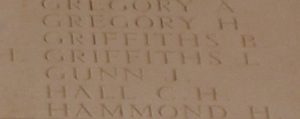
John Charles Hobbs, Private, 14485, South Wales Borderers. John was the son of Charles Hobbs and Margaret Hobbs (nee Davies), of 10, Pit Row, Ebbw Vale. He married Cecelia Ann Moores in 1906 and the couple set up home at Bridgend Building, Rassau, where their three daughters were born over the coming years. Cecelia died in childbirth in 1913, so two daughters went to live with Mrs Dobbs, at 1, Rock Cottage, Rassau, whilst the third went to live with Mrs Holman, at 2, Partridge Row, Beaufort. John enlisted at Brecon into the 5th Battalion, South Wales Borderers soon after the outbreak of war. The battalion formed at Brecon before moving to Park House Camp, near Tidworth, to join 58 Brigade, 19th (Western) Division. The men spent the winter in billets at Basingstoke, where in January 1915 the battalion became the Pioneer Battalion to the 19th Division. The Division began landing in France on 19 July 1915, then moved to the Nursery Sector at Calonne for trench initiation alongside the Dehra Dun Brigade. The infantry battalions of the division then began carrying out the usual routines of rotating in the trenches: four days in the front line; four in support; and four in reserve, interspersed with training regimes and carrying out working parties and trench raids. Just south, the British launched a great offensive around the town of Loos on 25 September 1915, and the 19th Division was ordered to attack from its positions at the same time, to attempt to draw enemy attention away from the main battle area. The attacking battalions of the 19th Division were in place by 04.00, and then at 05.50 the men climbed out of their trenches to launch their assault, behind a gas and smoke screen. The assault was a disaster, and heavy casualties were suffered by the 19th Division for no gain. The Division wintered on the Somme and in February followed the German withdrawal to the Hindenburg Line. During the middle of March 1917, the Division was relieved from the line and began to move north, taking over positions in the Ypres Salient, and on 7 June took part in the assault on Messines Ridge, which was famously preceded by the blowing of a series of 19 huge underground mines. The 19th Division saw heavy fighting during the battle, then enjoyed a short spell in reserve before moving back into the line on 11 September, taking over a section of trenches running from the Ypres-Comines Canal to Belgian Wood. On 20 September the Division attacked past Hollebeke Chateau, to Hessian Wood, suffering heavy casualties. The Division wintered in the Cambrai sector, following the closure of the Battle of Cambrai, and was holding a section of the line in the Flesquières Salient. On 21 March 1918 the Germans launched the first of three offensives on to the section of the front running from Flesquières to St. Quentin, and the 19th Division was thrown into desperate fighting as it was pushed back over the coming days. The battered Division was then moved to the Messines sector to rest, but on 11 April became caught up in the second phase of the German offensive, which had been launched along the Lys Valley on 9 April, and again became caught up in desperate fighting. The remnants of the Division were moved south to the Aisne sector to rest and rebuild, but by sheer bad luck, the Germans third, and last, offensive was launched here on 27 May 1918, and the Division was once more caught up in desperate fighting. At some time during these terrible months, John had been taken ill and been evacuated back to Britain. He was taken to the Lord Derby War Hospital at Warrington, where he died of cerebro-spinal fever on 6 June 1918. The remains of the 36-year-old were conveyed home and he was buried in St. David’s Churchyard, Beaufort.
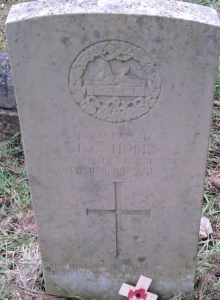
Henry Johns, DSC, Master, Mercantile Marine. Henry was born in Solva, Pembrokeshire in 1857, the son of Joseph John and Rebecca John (nee Griffiths). He left home as a young man to join the Mercantile Marine and lodged with an aunt, Mary Powell, in Cardiff. In about 1882, Henry married Sarah Ellen Jones, a schoolteacher from Beaufort, and she set up the family home at 7, Beauford Road, Ebbw Vale. Henry thrived at sea and by 1881 had gained his Masters Certificate at Liverpool, entitled him to be a Ships Captain. By the time war erupted, Henry was Captain of the SS Whitefield. She was shelled and sunk by a German submarine on 1 September 1915, but Henry and all his crew survived, taking to the ships lifeboats before the ship was sunk. Upon safely returning to Britain, Henry was given command of SS Tantallon, before becoming Captain of the defensively armed merchant steamer, SS Haslingden. Henry was awarded the Distinguished Service Cross for War Services, in the London Gazette of 16 November 1917. On 12 May 1918, Haslingden was approaching the Tyne and was some seven miles east of Seaham Harbour, returning from Rouen, when she was torpedoed without warning and sunk by the German submarine UB-21. The torpedo blew up directly beneath the bridge, hitting the engine room, killing Henry and several other crewmen instantly. Henry was 60 years old when he was killed that day, and is commemorated on the Tower Hill Memorial, London.
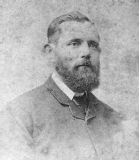
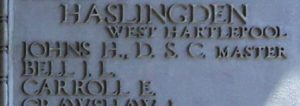
David Jones, Private, 20560, South Wales Borderers. David was born at Beaufort in around 1888. He married Hannah Jane Davies in 1913 and the couple set up home at 99, Canning Street, Cwm. David enlisted into the 10th Battalion, South Wales Borderers at Cwm soon after the outbreak of war. The Division trained in North Wales before moving to Winchester in the summer of 1915, where the formation became renumbered 113 Brigade, 38th (Welsh) Division. The Division began moving to France on 2 December 1915 and moved to the Nursery Sector near Fleurbaix for trench initiation alongside the Guards Division. The Division then held a sector of the line near Cuinchy before marching south to the Somme sector in June 1916 to take part in the assault on Mametz Wood. The first attack on the wood was launched on a two-battalion front on 7 July, but failed, and the Divisional Commander, Sir Ivor Philipps, was replaced before the Division attacked again on a two Brigade front on 10 July 1916. David was killed in action in the wood on 10 July 1916. The 28-year-old has no known grave and is commemorated on the Thiepval Memorial, France. The St. David’s War Memorial states Welsh Regiment, but this is the correct man.
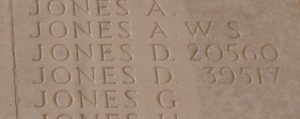
William Henry Jones, Private, 13624, South Wales Borderers. William was the son of George Jones and Emmaline Ann Jones, of 40, Gwyn’s Row, Beaufort. He worked as a coal hewer prior to enlisting at Brecon into the South Wales Borderers in August 1914. In January 1915 he was posted to Rugby, to join the 2nd Battalion, South Wales Borderers, which had recently arrived following service in China. The battalion had landed at Plymouth on 12 January 1915, before entraining for Rugby to join 87 Brigade, 29th Division. On 17 March 1915 the battalion sailed from Avonmouth with the Division, arriving at Alexandria on 29 March, before moving to Mudros. On 25 April 1915 the Division landed at Cape Helles, Gallipoli, as part of the original landing force which had been despatched to try and seize the Dardanelles Straits and force Turkey out of the war. The invasion forces failed to break the Turkish defences and the campaign became bogged down. William was wounded later in the campaign, during fighting around Turkey Trench, and died of his wounds on 22 August 1915. The 37-year-old is buried in Hill 10 Cemetery, Gallipoli.
Evan William Lewis, Private, 19374, South Wales Borderers. Evan was the son of William Jarman Lewis and Mary Lewis, of 36, New Colliers Road, Ebbw Vale. He married Rose Hannah Isaacs on 13 June 1905 and the couple set up home at 2, South Street, Beaufort. Evan worked as a labourer prior to enlisting into the South Wales Borderers at Brynmawr on 24 March 1915. He was posted to the Depot at Brecon, where he joined the 3rd Battalion, South Wales Borderers, the regiments reserve unit, which was at Pembroke Dock. As he began his training it became apparent that Evan’s health was failing, and he was discharged from the army as medically unfit on 28 April 1915. He was too ill to return home and was taken to Pembroke Dock Military Hospital, where he died of tuberculosis on 9 May 1915. Nothing more is known of Evan, as he is not commemorated by the CWGC.
Ethel Annie Llewelyn, Nurse, Voluntary Aid Detachment. Ethel was the daughter of the Vicar of Beaufort, Reverend David Jones Llewellyn, and his wife, Annie Llewellyn (nee Kershaw), of The Vicarage, Beaufort. She was educated at St Stephen’s College, Clewer, St Stephen, Windsor, but following the outbreak of war volunteered to serve as a Nurse with the Voluntary Aid Detachment at the Welsh Hospital, Netley. The Hospital was originally built in 1855 to treat soldiers from the Crimean War and had been funded by donations from people around Wales. Members of the Welsh Hospital served in South Africa during the Boer War of 1899-1902, suffering several deaths from sickness and disease during the campaign. The hospital was to see its greatest use, however, during the Great War, when countless thousands of men were treated there. Ethel served at Netley throughout the war, but contracted tuberculosis during her time there. After the Armistice she was sent to the Sanatorium at Llangwyfan, in Denbighshire for treatment, but she sadly died there of tuberculosis on 13 April 1921, aged 25. Ethel was buried in Llangwyfan Churchyard three days later. Ethel is not commemorated as a war casualty by the CWGC but is commemorated on an individual memorial plaque in St. David’s Church, Beaufort.
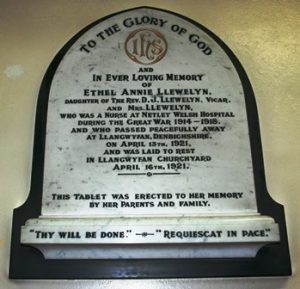
William John Martin, Private, 1682, Royal Army Medical Corps. William was the son of William Martin and Margaret Jane Martin (nee Day), of 54, Harcourt Street, Ebbw Vale. He worked as a collier at Beaufort prior to enlisting into the 1st (Welsh) Field Ambulance, Royal Army Medical Corps (Territorials) at Ebbw Vale on 1 May 1914. William passed his training course prior to the outbreak of war and was mobilised with the 1st (Welsh) Field Ambulance on 5 August 1914. The unit formed part of the 53rd (Welsh) Division, a formation created by the establishment of the Territorial Force in 1908. Several of the Divisions units left between November 1914 and February 1915 to act as reinforcements to Divisions already in the field. These were gradually replaced by Second-Line units. In November 1914, an order for the Division to proceed to India was eventually cancelled and the 53rd (Welsh) Division sailed from Devonport for the Mediterranean in July 1915, reaching Mudros on 5 August 1915. From here the Division moved to Gallipoli, landing on 9 August 1915. Here the Division was immediately thrown into action, and spent the next few days in isolated pockets, taking heavy casualties during the Turkish counterattack during the Battle of Sari Bair, then the ensuing Attack on Scimitar Hill. The Division remained here throughout the coming months and suffered severe losses in manpower strength during the great November 1915 blizzard on Gallipoli, when its total strength was reduced to less than that of a full-strength Brigade. William took ill towards the end of the campaign and was evacuated off the Peninsula. He eventually arrived back in Britain on 8 November and was taken to the Welsh Metropolitan Hospital at Cardiff, where he was diagnosed as suffering from tuberculosis. William was discharged from the army as medically unfit on 11 May 1916 and spent a while in a Sanatorium, before returning home, where he died of tuberculosis on 27 May 1917, aged 22. Nothing further is presently known of him, as he is not commemorated by the CWGC.
Ernest Miles, Private, 2637, Monmouthshire Regiment. Ernest was the son of Henry and Mary Miles, of Odd Down, Bath. He lodged at 12, Glanyrafon Terrace, Beaufort prior to the war, where he worked as a coal hewer. Ernest enlisted into the 3rd Battalion, Monmouthshire Regiment at Abergavenny soon after the outbreak of war. The battalion mobilised at Abergavenny attached to the Welsh Border Brigade, Welsh Division, before moving to Pembroke Dock. On 10 August 1914 the Division moved to Oswestry before moving to Northampton, then spent Christmas at Bury St. Edmunds before moving to Cambridge. In February 1915 the 3rd Monmouth’s left the Welsh Division and landed in France on 14 February, before moving to the Ypres Salient. On 3 March 1915 the battalion joined 83 Brigade, 28th Division. On 8 April the 3rd Monmouth’s relieved a French Division in the sector east of the Polygon Wood to begin its first tour in the trenches. The battalion was relieved four days later, and marched to billets in Ypres, then on 17 April relieved the 5th King’s Own in the front line, to begin a spell which would last for 17 days without relief. On 22 April, just to the north, the Germans launched the first gas attack of the war upon French Colonial troops at Gravenstafel, heralding the opening of the Second Battle of Ypres. Ernest was killed in action near Polygon Wood on 2 May 1915, just prior to the wood being evacuated. The 25-year-old has no known grave and is commemorated on the Ypres (Menin Gate) Memorial, Belgium.
David George Morgan, Private, 1867, Royal Army Medical Corps. David was the son of David William Morgan and Jane Morgan (nee Robins), of 8, Post Office Row, Newtown, Ebbw Vale. He worked as a coal hewer prior to enlisting at Ebbw Vale into the 1st (Welsh) Field Ambulance, Royal Army Medical Corps (Territorials). The 1st (Welsh) Field Ambulance mobilised on 5 August 1914 as part of the 53rd (Welsh) Division. The Division was a formation created by the establishment of the Territorial Force in 1908. Several of the Divisions units left between November 1914 and February 1915 to act as reinforcements to Divisions already in the field. These were gradually replaced by Second-Line units. In November 1914, an order for the Division to proceed to India was eventually cancelled and the 53rd (Welsh) Division sailed from Devonport for the Mediterranean in July 1915, reaching Mudros on 5 August 1915. From here the Division moved to Gallipoli, landing on 9 August 1915. Here the Division was immediately thrown into action, and spent the next few days in isolated pockets, taking heavy casualties during the Turkish counterattack during the Battle of Sari Bair, then the ensuing Attack on Scimitar Hill. The Division remained here throughout the coming months and suffered severe losses in manpower strength during the great November 1915 blizzard on Gallipoli, when its total strength was reduced to less than that of a full-strength Brigade. David became ill towards the end of the Gallipoli campaign and was evacuated to the 15th Stationary Hospital at Mudros, where he died of paratyphoid on 24 December 1915. The 20-year-old is buried in East Mudros Military Cemetery, Greece.
John Morris, Private, Deal 4388/S, Royal Marines. John was born on 7 July 1891, the son of William and Joanna Morris, of Linebridge Cottage, Rassau. He worked as a collier at the Tunnel Colliery, Ebbw Vale prior to enlisting into the Royal Naval Volunteer Reserve on 8 September 1915 and on 17 March 1916 was transferred to the Royal Marines Medical Unit. John was drafted to France on 11 May 1917 and was posted to the 2nd (Royal Naval) Field Ambulance, in the 63rd (Royal Naval) Division. The Division was at Arras and saw heavy fighting during the Battle of Arras, before moving north to Ypres in October to join the offensive for Passchendaele Ridge. John was killed at Passchendaele whilst carrying a wounded soldier from the battlefield on 26 October 1917. The 26-year-old is buried in Tyne Cot Cemetery, Belgium.
Stanley Plummer, Lance Sergeant, 2913, Monmouthshire Regiment. Stanley was the son of Thomas Plummer and Elvira Plummer (nee Hughes), of No. 18, 2nd Row, Newtown, Ebbw Vale. By 1911 he was residing at 7, New Gantra, Beaufort, where he worked as a coal miner. Stanley enlisted into the 3rd Battalion, Monmouthshire Regiment at Abergavenny. The battalion mobilised at Abergavenny attached to the Welsh Border Brigade, Welsh Division, before moving to Pembroke Dock. On 10 August 1914 the Division moved to Oswestry before moving to Northampton, then spent Christmas at Bury St. Edmunds before moving to Cambridge. In February 1915 the 3rd Monmouth’s left the Welsh Division and landed in France on 14 February, before moving to the Ypres Salient. On 3 March 1915 the battalion joined 83 Brigade, 28th Division. On 8 April the 3rd Monmouth’s relieved a French Division in the sector east of the Polygon Wood to begin its first tour in the trenches. The battalion was relieved four days later, and marched to billets in Ypres, then on 17 April relieved the 5th King’s Own in the front line, to begin a spell which would last for 17 days without relief. On 22 April, just to the north, the Germans launched the first gas attack of the war upon French Colonial troops at Gravenstafel, heralding the opening of the Second Battle of Ypres. The fighting remained to the north of Polygon Wood until 3 May, when the Germans widened their attacks and the Polygon Wood sector was evacuated by the 28th Division, which fell back on the G.H.Q. line at Potijze. Over the coming days their new positions were shelled mercilessly, then on 8 May the Germans attacked. Despite heavy losses the Division held firm and later that day three Companies of the 3rd Monmouth’s moved back into billets at Vlamertinghe, leaving B Company in the line. By now casualties had become so severe that on 10 May a Composite Battalion was formed from remnants of 83 Brigade, under Lt Col Gough, and proceeded to the G.H.Q. line at Potijze. During the coming weeks, all three battalions of the Monmouth’s, which were all at Ypres, suffered such heavy losses that on 27 May they were merged at Vlamertinghe in 84 Brigade, 28th Division. On 11 August 1915 the individual battalions resumed identity and the 3rd Monmouth’s re-joined 83 Brigade, before becoming the Pioneer Battalion to the 49th (West Riding) Division in September 1915. The Division was at that time holding the Canal Bank sector, north of Ypres, and the 3rd Monmouth’s billeted near Elverdinghe, before beginning work on the canal bank drainage systems and defences over the coming weeks. The battalion was parading ready to leaves camp on 29 December 1915 when a salvo of four heavy German shells crashed into the camp, killing Stanley and 31 other men outright, and wounding 36 others. Stanley was 25 years old when he was killed that day and is buried in what amounts to a mass grave in Ferme Olivier Cemetery, Ieper, Belgium.
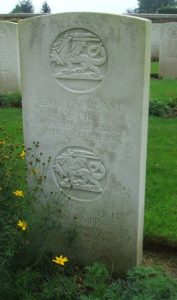
William John Price, Sergeant, 16170, South Wales Borderers. William was the son of William Price and Mary Price (nee Morgan), of 372, 30th Row, Sirhowey. He worked as a coal miner and married Emily Martin in about 1912. William enlisted at Newport into the South Wales Borderers soon after the outbreak of war. He was then posted to the 12th Battalion, South Wales Borderers. The battalion was raised at Newport by the Welsh National Executive Committee in March 1915 as a bantam Battalion, then in July 1915 moved to Prees Heath to join the Welsh Bantam Brigade. During September 1915 the Brigade moved to Aldershot and became 119 Brigade, in the 40th (Bantam) Division. In December 1915 the Division moved to Blackdown to complete its training before embarking for France and landing at Le Havre on 2 June 1916. The Division moved to positions around Lillers before taking over the North Maroc Sector, near Loos, for trench initiation and once acclimatised was left to hold the sector itself over the coming months. The infantry battalions of the Division then began the usual routines of rotating for duty in the trenches: normally four days in the front line; four in support and four in reserve. Late in 1916 the Division moved south to the Somme, and fought at the Battle of the Ancre, before remaining in the sector over the winter. In March 1917 the Germans withdrew to their shortened line, called the Hindenburg Line, and the 40th Division was among the units which followed the withdrawal. Later in the year the Division took part in the Battle of Cambrai and launched an attack on Bourlon Wood on 23 November 1917. The attack was carried out by 119 Brigade, led by the 12th SWB and 19th RWF. The 17th Welsh was in support for the initial assault, but was soon ordered to advance, to support the two attacking battalions. Heavy fighting raged within the wood over the coming days, with the 18th Welsh also being thrown forwards into the fight, and the Division suffered terribly. William was badly wounded at Bourlon Wood and was evacuated to a Casualty Clearing Station at Manancourt, where he died of his wounds on 26 November 1917. The 31-year-old is buried in Rocquigny-Equancourt Road British Cemetery, Manancourt, France.
Albert James Priddy, Private, 3/5174, Duke of Cornwall’s Light Infantry. Albert was the son of Edward John Priddy and Jane Priddy (nee Owens), of Vale Avoca, Beaufort. He worked as a Mason’s Labourer prior to enlisting into the 3rd Battalion, Duke of Cornwall’s Light Infantry in London some years before the war. When war broke out, Albert was in Bodmin with the battalion, but was drafted to France on 1 November 1914, joining the 1st Battalion, Duke of Cornwall’s Light Infantry, which was attached to 14 Brigade, 5th Division. The Division had been in France since the outbreak of war, taking part in the Battle of Mons and the subsequent retreat to the Marne, then fought at the Battles of the Marne and the Aisne before moving to Flanders with the BEF. The Division fought at the Battle of La Bassée, then at Messines in October 1914. It fought here throughout the First Battle of Ypres, and took part in the capture of Hill 60, before taking part in the Second Battle of Ypres in April 1915. The Division remained at Ypres until March 1916, when it moved south to positions between St. Laurent-Blangy and Vimy, near Arras, and saw plenty of action during its spell there. Further south, on 1 July 1916 the Battle of the Somme opened, and the Division was relieved from Arras in the middle of July, before being transferred to the Somme. Albert was posted as missing, believed killed in action on the Somme on 23 July 1916. The battalion was not even in the line by then, so what happened to him is a mystery, but a note on one of his medal cards states that he was attached to the 18th Divisional Train, which was also on the Somme, heavily involved during the fighting throughout July. The 22-year-old has no known grave and is commemorated on the Thiepval Memorial, France.
Stanley Trevelyan Rees, Sergeant, 20441, South Wales Borderers. Stanley was the son of William Fairfax Pontin Rees, and Maud Mary Rees (nee Hunt), of Tenby House, York Place, Newport, Mon. His father gained the position of Clerk of the Ebbw Vale Steelworks prior to the war and the family moved to 81, Badminton Grove, Ebbw Vale. Stanley enlisted into the 10th Battalion, South Wales Borderers at Cwm soon after the outbreak of war. The battalion was at Colwyn Bay attached to the 43rd (Welsh) Division. The Division trained in North Wales before moving to Winchester in the summer of 1915, where the formation became renumbered 113 Brigade, 38th (Welsh) Division. The Division began moving to France on 2 December 1915 and moved to the Nursery Sector near Fleurbaix for trench initiation alongside the Guards Division. The Division then held a sector of the line near Cuinchy before marching south to the Somme sector in June 1916 to take part in the assault on Mametz Wood. The first attack on the wood was launched on a two-battalion front on 7 July, but failed, and the Divisional Commander, Sir Ivor Philipps, was replaced before the Division attacked again on a two Brigade front on 10 July 1916. After two days of ferocious hand-to-hand fighting, the wood was cleared up to its northern edge, before the battered Division was relieved. It then took over a section of the front at Hébuterne before moving to the Ypres Salient and taking over the Canal Bank sector at Boesinghe. The infantry battalions of the Division then began carrying out the normal pattern of rotation in the trenches, four days in the front, four in support and four in reserve, whilst also working on trench improvement, digging new trenches, and carrying out regular patrols and trench raids. On 31 July 1917 the Division launched its famous assault on the Pilckem Ridge, capturing Iron Cross and reaching its objective of the Steenbeek, then played a supporting role in the Battle of Langemarck. The Division was transferred to the Sailly-sur-la-Lys sector in September and remained in the area over the winter before being moved to positions north of Albert, at Bouzincourt Ridge, at the end of March 1918, relieving the battered 2nd and 47th Divisions. On 25 April the 10th SWB moved into the front line on the ridge, relieving the 2nd RWF, to begin a routine tour in the trenches. Stanley was killed here when the battalion lines were hit by a salvo of German gas shells two days later, on 27 April 1918. The 21-year-old is buried in Bouzincourt Communal Cemetery Extension, France.
Richard Tudor Reese, Captain, The King’s (Liverpool Regiment). Richard was born at Beaufort on 18 May 1890, the son of Henry William Fisher Reese and Sarah Reese (nee Matthews). He worked as a furnace slagger in an ironworks prior to the war, and resided at 125, Mount Pleasant Road, Ebbw Vale. Richard originally enlisted into the Royal Garrison Artillery, but before he had the chance to serve overseas, gained a commission as Second Lieutenant into the 3rd Battalion, Monmouthshire Regiment. Richard was promoted to Lieutenant on 5 March 1918, then to Captain soon afterwards, whilst attached to the 1st Battalion, The King’s (Liverpool Regiment). The battalion was attached to 6 Brigade, 2nd Division and had been in France since the outbreak of war. In the summer of 1916, the Division was on the Somme, and took part in the Battle of Delville Wood, then in the Battle of the Ancre, and the ensuing Operations on the Ancre. In March 1917 the Division followed the German Retreat to the Hindenburg Line, and in April fought at Arras, during the First Battle of the Scarpe, the Battle of Arleux and the Third Battle of the Scarpe. Its next major action was at the Battle of Cambrai, and the Division was still in the area in March 1918 when the Germans launched their Spring Offensive on the Somme on 21 March 1918. The Division was then caught up in heavy fighting as the line was driven backwards over the coming days. The Division then rebuilt before taking part in the launching of the great offensive, which began on 21 August. The Division was holding the Ayette Sector, near Monchy, in the weeks leading up to the great advance. The opening barrage began at 04.50 and the 1st Liverpool’s moved to positions south of Douchy, in reserve, where great swarms of German prisoners were seen. The battalion bivouacked on the ridge west of Douchy as the attacking battalions continued their advance, then on 23 August moved into assembly positions on the Courcelles Road, ready to take up the offensive. The battalion then attacked towards Ervillers, supported by several Whippet Tanks, from a line east of the Achiet-le-Grand to Arras Road, following a creeping artillery barrage. Ervillers was captured that day, then on the following night the battalion launched an assault against Mory. Richard was killed in action at some time between the launch of the assault on 23 August and the battalion’s relief on 25 August 1918. The body of the 28-year-old was later recovered, and he was buried in Bucquoy Road Cemetery, Ficheux, France.
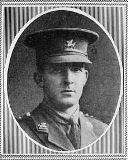
Joseph Rowe, Master, Mercantile Marine. Joseph was born at West Hartlepool in 1881, the son of William Rowe and Caroline Rowe (nee Enderwick). He went to sea as a young man, and later set up home at Nine Wells, Solva, Pembrokeshire. Joseph married Sarah Elizabeth Johns, the daughter of Captain Henry Johns (above), of Caegwyn, Beaufort and Solva at St. David’s Church, Beaufort on 12 June 1914. By the time war erupted, Joseph was Master of the SS Albania, but later served as Master of the SS Bayvoe. He died of a ruptured gastric ulcer at Genoa on 14 May 1918. Joseph is not commemorated as a war casualty by the CWGC. His widow, Sarah, died at Cae Gwyn, Solva on 22 August 1975, after having never remarried.
Joe Seabourne, Private, 62690, Monmouthshire Regiment. Joe was the son of Eli Seabourne and Margaret Seabourne (nee Smith), of Gilwern, Llanelly. His father died before his birth, so Joe was raised by his mother at his eldest brother’s home at Llanelly. By 1901 he was working as a shop assistant at Llanelly, then by 1911 he was an inmate at the Crickhowell Union Workhouse and Infirmary but stated that he was married and that his former trade was of a limestone quarryman. Joe had enlisted into the Monmouthshire Regiment soon after the outbreak of war and was posted to Bedford with the 3rd (Reserve) Battalion. He was court martialled in Bedford, before being transferred to the 5th Battalion, South Wales Borderers and served on the Western Front at some time. Joe was then transferred to the 2nd Battalion, Monmouthshire Regiment. Little else is presently known of him, but Joe died at Herne Bay Military Hospital in Kent on 10 December 1918. The remains of the 36-year-old were brought home and he was buried in Ebbw Vale Cemetery.
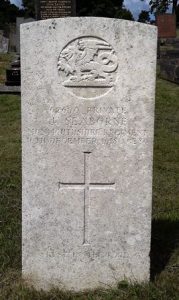
Alexander Shellady, Corporal, 17103, Royal Defence Corps. Alexander was born at Shank Hill Road, Belfast in about 1857, the son of William Shellady and Mary Ann Shellady. His father was a Gunner with the Royal Artillery, and the family moved to the Channel Irelands when Alexander was very young. Alexander enlisted into the Somerset Light Infantry, and served until 1885, when he was discharged and moved to Taunton, where he married Mary Ann Small in 1889. The couple then moved to Thomas Row, Beaufort, where Alexander had gained work as a steel worker. By 1911 the family had moved to 9, William Street, Ebbw Vale and Alexander was still working as a steel worker. He re-enlisted into the army at the outbreak of war, joining the Monmouthshire Regiment at Ebbw Vale, but due to his age was later transferred to the 331st Company, Royal Defence Corps. The Royal Defence Corps was introduced by a Royal Warrant of 17 March 1916 and was utilised in a home defence role. Alexander was serving in Cheshire with his company soon after its formation, when he took ill and was invalided to the Alexandra Park Military Hospital at Stockport. He died there of heart failure on 11 May 1916, aged 60. His remains were conveyed home and he was buried in St. David’s Churchyard, Beaufort. Alexander is not commemorated on the St. David’s War Memorial.
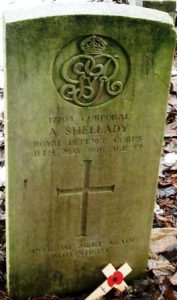
John Shepherd, Private, 20301, South Wales Borderers. John was born on 19 November 1876, the son of William Shepherd and Eliza Shepherd (nee Holvey), of Chapel House, Newtown, Ebbw Vale. He married Emily Jane Jones on 16 July 1901 and the couple lived at 4, Gantra Row, Ebbw Vale. John worked as a collier prior to enlisting into the 10th Battalion, South Wales Borderers at Ebbw Vale soon after the outbreak of war. The battalion was at Colwyn Bay attached to the 43rd (Welsh) Division. The Division trained in North Wales before moving to Winchester in the summer of 1915, where the formation became renumbered 113 Brigade, 38th (Welsh) Division. The Division began moving to France on 2 December 1915 and moved to the Nursery Sector near Fleurbaix for trench initiation alongside the Guards Division. The Division then held a sector of the line near Cuinchy before marching south to the Somme sector in June 1916 to take part in the assault on Mametz Wood. The first attack on the wood was launched on a two-battalion front on 7 July, but failed, and the Divisional Commander, Sir Ivor Philipps, was replaced before the Division attacked again on a two Brigade front on 10 July 1916. After two days of ferocious hand-to-hand fighting, the wood was cleared up to its northern edge, before the battered Division was relieved. It then took over a section of the front at Hébuterne before moving to the Ypres Salient and taking over the Canal Bank sector at Boesinghe. The infantry battalions of the Division then began carrying out the normal pattern of rotation in the trenches, four days in the front, four in support and four in reserve, whilst also working on trench improvement, digging new trenches, and carrying out regular patrols and trench raids. On 31 July 1917 the Division launched its famous assault on the Pilckem Ridge, capturing Iron Cross and reaching its objective of the Steenbeek, then played a supporting role in the Battle of Langemarck. John must have been invalided home sick or wounded at some time and upon his return to France was posted to the 2nd Battalion, South Wales Borderers, which was attached to 87 Brigade, 29th Division. The Division had also been at Ypres and had in fact relieved the 38th Division on the Canal Bank for it to go out of the line to train. Early in October 1917 the 29th Division was relieved from the line at Ypres, and moved south to the Bellacourt area, to prepare to take part in the forthcoming Battle of Cambrai. The Division entrained for Péronne on 17 November, marching to a camp four miles out of the town at Haut Allaines, then by midnight on 18 November had reached Fins. On the following day the Division received its battle stores and detailed orders for the forthcoming battle, marching off via Gouzeaucourt to its assembly positions at Marcoing. The assault began at dawn on 20 November, but the Division suffered terrible casualties whilst attacking Masnières, on the Hindenburg Line. John was killed in action during the assault, on 21 November 1917. The 41-year-old has no known grave and is commemorated on the Cambrai Memorial, Louverval, France.
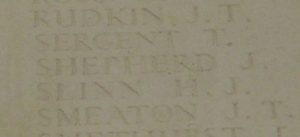
Richard Samuel Smith, Private, 12973, Royal Army Medical Corps. Richard was born in Birmingham in 1898, the son of Moses and Mary Smith. He enlisted into the Oxfordshire and Buckinghamshire Light Infantry soon after the outbreak of war and embarked for France on 7 April 1915, probably joining the 2nd Battalion, Oxfordshire and Buckinghamshire Light Infantry, which was attached to 5 Brigade, 2nd Division. Richard must have been invalided home at some time afterwards, either through wounds or sickness and was transferred to the Royal Army Medical Corps. He married Mary Evelyn Wood, of 6, Waengoch, Beaufort at Beaufort on 27 July 1918 whilst on leave. Richard was based at a military camp in Wiltshire and returned there soon after his wedding. Sadly, he took ill soon afterwards and died of sickness at the Military Hospital at Chiseldon Camp, Wiltshire on 8 October 1918. The remains of the 20-year-old were brought home to Birmingham, and he was buried there in Yardley Cemetery. His widow, Mary, had given birth to their only child, a daughter, Gladys May Smith, on 9 September 1918.
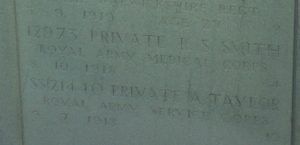
William Charles Stokes, Private, 67664, Cheshire Regiment. William was the son of William Stokes and Sarah Ann Stokes (nee Phillips), of Holly Bush Cottage, Rassau. He worked as a collier prior to enlisting into the 13th (Reserve) Battalion, South Wales Borderers at Abertillery on 21 August 1915 and joined the battalion at Kinmel Park. William lied about his age at enlistment, so remained in Kinmel Park for over a year before being transferred to the 59th Battalion, Training Reserve. He did not embark for France until 2 April 1918 and upon disembarkation joined the 9th Battalion, Cheshire Regiment, which was attached to 56 Brigade, 19th (Western) Division. The Division had suffered terrible casualties the previous month, following its heroic defence of Beugny and the ensuing withdrawal towards Hébuterne, following the opening phase of the German Spring offensive and had moved to positions near Ploegsteert to rest and refit. Unfortunately, on 9 April 1918 the Germans launched the second phase of their Spring offensive along the Lys Valley and the 19th Division was hit hard once more over the coming days. William was badly wounded during the first day of the fighting and was evacuated to the 2nd Canadian Casualty Clearing Station at Lijssenthoek, where he died of his wounds on 11 April 1918. The 18-year-old is buried in Lijssenthoek Military Cemetery, Belgium.
Sydney John Thomas, Private, 108853, Machine Gun Corps. Sydney was born in London on 18 November 1896, the son of John Thomas and Maria Thomas (nee Jones). His parents were both native of Breconshire, so when Sydney’s father died soon after his birth, his mother, Maria, moved back to Wales with her young family and set up home at 99, The Rise, Beaufort. Sydney enlisted into the Monmouthshire Regiment at Ebbw Vale in 1915, and after completing his training was transferred to the 28th Company, Machine Gun Corps. The Company was attached to the 9th (Scottish) Division and had formed in January 1916. The Company then took part in the Battle of the Somme, fighting at the opening Battle of Albert, and then at the Battle of Bazentin, where the 9th Division captured Longueval. The Division then fought at the Battle of Delville Wood, and the Battle of Le Transloy, before moving to Arras, where it fought at the First Battle of the Scarpe and the Third Battle of the Scarpe. The Division then moved north to Ypres, and fought at the Battle of the Menin Road, and at the First Battle of Passchendaele, before being moved to Cambrai, and fighting at the Action of Welsh Ridge. In February 1918 the British Army re-organised its Brigades and Machine Gun units, so Sydney was transferred to the 51st Battalion, Machine Gun Corps, in the 51st (Highland) Division. The Division was in the Cambrai sector when the Germans launched their Spring offensive on 21 March 1918 and saw heavy fighting as it was forced to withdraw over the coming days. Upon being relieved, the Division moved to Bethune to rest, unfortunately, the enemy opened a second phase of his offensive, now called the Battle of the Lys, on 9 April 1918 and the Highland Division moved into defensive positions behind Richebourg Saint Vaast, where it played a key part in beating off incessant attacks. At the beginning of May, the Division moved to Oppy near Arras, where it stayed until 11 July in a relatively quiet spell, however, when the Germans launched their third offensive of the year in the Aisne, the Division was sent south to assist. It saw several days of very heavy fighting, before the Germans were held and the Division then took part in a series of counterattacks. Sydney was wounded during a large-scale assault against Chaumuzy on 27 July 1918. He was taken to the 2/1st Highland Field Ambulance for treatment but died there of his wounds on 28 July 1918. The 21-year-old is buried in Marfaux British Cemetery, France.
Thomas Henry Titley, Private, 401116, Manchester Regiment. Thomas was the son of Isaac Titley and Emily Titley (nee Watkins), of Valley View, Beaufort. He married Blanche Emily Cooper in 1907 and the couple set up home at 3, Valley View, Beaufort. Thomas worked as a coal hewer prior to enlisting at Ebbw Vale into the 10th Battalion, South Wales Borderers soon after the outbreak of war. The battalion was training in North Wales attached to the 38th (Welsh) Division, however soon after arriving in North Wales, Sydney transferred into one of the regular battalions of the regiment and embarked for France on 3 April 1915. He must have been invalided home wounded at some point as upon his returned to France he transferred to the 1/8th Battalion, Manchester Regiment. The battalion was attached to 127 Brigade, 42nd (East Lancs) Division and had seen service at Gallipoli and in Egypt before moving to France in March 1917, taking over the line near Épehy then Havrincourt. In September the Division moved north to Ypres and fought during the early stages of the Third Battle of Ypres, until moving to the Coast in September to refit. November 1917 saw the Division moving to positions at Givenchy, where it remained until moving back south in early 1918. Here the Division faced the German Spring Offensive of 21 March on the Somme and fought a rear-guard action over the coming days whilst the British line was driven back. The fighting moved north on 9 April, when the Germans launched the second phase of their Spring offensive along the Lys Valley, and the 42nd Division took the chance to rebuild, whilst holding the line near Essars. On 7 April the 1/8th Manchester’s moved into the front line to begin a routine tour in the trenches, and two days later was relieved, before being moved by lorries into reserve billets at Henu. The battalion remained here until 15 April when it moved into reserve positions near Foncquevillers, remaining here until taking over the front line on 25 April, to begin another routine tour. Thomas was wounded soon afterwards and was evacuated to a nearby Casualty Clearing Station, at Gézaincourt. He died of his wounds there on the following day, 26 April 1918. The 30-year-old is buried in Bagneux British Cemetery, Gézaincourt, France.
Sidney Arthur James Vaughan, Private, 85696, Durham Light Infantry. Sidney was born at Ross, Herefordshire in 1899, the son of Sydney Vaughan and Jane Vaughan (nee Lambert). The family moved to Llantilio Crosseny by 1901, before moving again to 6, Waungoch Terrace, Beaufort. Sidney was a furnace worker prior to enlisting into the army at Abertillery on 16 December 1916 and was initially placed on the Army Reserve. He was mobilised at Cardiff on 17 April 1917 and was posted to the 2nd (Garrison) Battalion, Royal Welsh Fusiliers. Sidney remained on home service in Ireland until embarking for France on 27 June 1918 and was transferred to the newly arrived 29th Battalion, Durham Light Infantry, which was attached to 41 Brigade, 14th (Light) Division. The Division had been virtually annihilated in the Spring of 1918 and was forced to go back to England to rebuild. Upon its return it joined the Second Army and later that year took part in the great advance in Flanders. Sidney remained in the army in France after the war. On 7 May 1919 he was posted from the Infantry Base Depot at Étaples to the 20th Battalion, Durham Light Infantry and went to Germany with the Army of Occupation. Sidney took ill after over a year in Germany and died of nephritis and endocarditis in hospital at Cologne on 28 August 1919. The 20-year-old is buried in Cologne Southern Cemetery, Germany.
Edward Whatley, Private, 20252, South Wales Borderers. Edward was the son of Francis Whatley and Elizabeth Whatley (nee Herridge), of 23, Gantra, Ebbw Vale. He married Eliza Jones in 1912 and the couple set up home at 2, Cyntra, Ebbw Vale, where their two children were born. Edward worked as a collier prior to enlisting at Ebbw Vale into the 10th Battalion, South Wales Borderers soon after the outbreak of war. The battalion was at Colwyn Bay attached to the 43rd (Welsh) Division. The Division trained in North Wales before moving to Winchester in the summer of 1915, where the formation became renumbered 113 Brigade, 38th (Welsh) Division. The Division began moving to France on 2 December 1915 and moved to the Nursery Sector near Fleurbaix for trench initiation alongside the Guards Division. By the beginning of February 1916, the 10th SWB had taken up billets at Croix Barbee, in Brigade Reserve. On 17 February the battalion left its billets and marched to new billets at Croix Marmeuse, where the men remained until moving to billets at Le Touret two days later. On 23 February the battalion relieved the 11th SWB in the front line to begin a routine tour in the trenches. Edward was killed in action during this relatively quiet tour, on 25 February 1916. The 31-year-old is buried in Le Touret Military Cemetery, Richebourg L’Avoue, France.
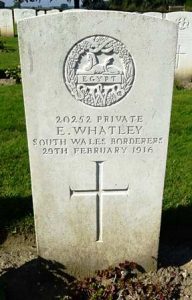
George Henry Williams, Private, 2646, Monmouthshire Regiment. George was the son of Jane Williams, of 36, Waengoch District, Beaufort. He married Margaret Davies at Beaufort in 1913 and the couple had a son, Emrys Williams, born the following year. George worked as a coal miner prior to enlisting into the 3rd Battalion, Monmouthshire Regiment. The battalion mobilised at Abergavenny attached to the Welsh Border Brigade, Welsh Division, before moving to Pembroke Dock. On 10 August 1914 the Division moved to Oswestry before moving to Northampton, then spent Christmas at Bury St. Edmunds before moving to Cambridge. In February 1915 the 3rd Monmouth’s left the Welsh Division and landed in France on 14 February, before moving to the Ypres Salient. On 3 March 1915 the battalion joined 83 Brigade, 28th Division, near Ploegsteert Wood. The 3rd Monmouth’s then moved into the trenches to begin a short period of trench initiation alongside a more seasoned battalion of the York and Lancaster Regiment. On the night of 15 March 1915, the battalion was holding a sector of the front line when George was shot in the neck and killed by a German sniper. The body of the 22-year-old was carried from the trenches, and he was buried by his comrades in St. Quentin Cabaret Military Cemetery, Belgium.
Tom James Williams, Private, 13016, South Wales Borderers. Tom was the son of William and Louisa Williams, of 3, Holly Bush Row, Rassau. He worked as a collier prior to enlisting at Newport into the 4th Battalion, South Wales Borderers soon after the outbreak of war. The battalion formed at Brecon, before moving to Park House Camp, near Tidworth to join 40 Brigade, 13th (Western) Division, then moved to billets in Cirencester before moving to Woking in March 1915 for final training. On 29 June 1915 the Division sailed from Avonmouth for Mudros, before landing at Cape Helles, Gallipoli on 15 July 1915. Two weeks later the Division was moved to Anzac, to reinforce the Australian and New Zealand troops there, in readiness for a great assault on the Sari Bair Ridge, in conjunction with fresh Allied landings at Suvla Bay. The assault began on 6 August 1915 and raged over the coming days. The 4th SWB reached the Achyl Dere before assaulting, and seizing Damakjelik Bair, one of the ridges held by the Turks. The Turks counter-attacked on 9 August and terrible fighting raged throughout the day. Tom was wounded during the day and was evacuated to the 7th Field Ambulance, where he died of his wounds on 10 August 1915. The 28-year-old is buried in the 7th Field Ambulance Cemetery, Gallipoli.
Bertram Willing, Private, 48247, Welsh Regiment. Bertram was the son of George Willing and Diana Willing (nee Jenkins), of Greenfield House, Wesley Place, Beaufort. He worked as a coal haulier above ground prior to the war. Bertram enlisted into the army at Ebbw Vale and after completing his training was posted to Salonika, joining the 11th Battalion, Welsh Regiment, which was attached to 67 Brigade, 22nd Division. The Division had been transferred from the Western Front to Salonika as part of an Anglo-French force in October 1915, to help guard the Greek frontier following the invasion of Serbia by a combined Austro-Bulgarian offensive. The Division remained in the theatre for the rest of the war, taking part in the Retreat from Serbia during December 1915, and took part in several pitched battles over the coming years. Between 10 to 18 August 1916, they Division fought at the battle of Horseshoe Hill, then between 13 to 14 September 1916 at the battle of Machukovo. Between 24-25 April and 8-9 May 1917, the Division fought at the battle of Doiran. Bertram was killed in action after the cessation of the latter battle, on 27 May 1917. The 26-year-old is buried in Karasouli Military Cemetery, Greece.
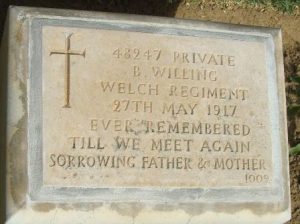
James William York, Private, 3125, Australian Machine Gun Corps. James was born in Zeehan, Tasmania, on 2 May 1892, the eldest son of Albert James York and Esther Maria York (nee Excell). The family moved to Sheffield, Tasmania, where James was educated, before becoming a schoolteacher at Burnie. James enlisted into the Australian Imperial Force at Claremont on 10 October 1916 and after initial training was posted to the 7th Reinforcements to the 40th Battalion. On 10 February 1917, James embarked from Outer Harbour, Adelaide aboard the transport ship Seang Bee, bound for England and upon his arrival he was sent to the 10th Training Battalion at Durrington. On 13 July, he was transferred to the Machine Gun Details Depot at Grantham, where he spent several months training before being drafted to France in October 1917, joining the 25th Machine Gun Company, Australian Imperial Force, which was in the Ypres Salient. The Company wintered in the Ypres Salient, carrying out the usual routines of trench rotation. To the south, on 21 March 1918 the Germans launched the first phase of their great offensive along the Somme, on a section of the Western Front running south from Croisilles to La Fère. The Allies were driven back over the coming days, so most of the Australians were transferred south to help bolster the line, moving into positions defending the vital town of Amiens. By now, the Machine Gun Companies had been re-organised, and James was now a member of the 5th Battalion, Australian Machine Gun Corps, which was attached to the 5th Australian Division. During the morning of 9 April 1918, James was in the front-line facing Villers-Bretonneux, digging a machine-gun position, when he was shot in the head and killed by a German sniper. James was buried by his comrades 100 yards behind the front line, but soon afterwards their positions were attacked by the Germans and his grave was lost. His grave was located during the post-war battlefield clearances, and he was re-interred in Crucifix Corner Cemetery, Villers-Bretonneux, France on 12 May 1919. Two of his cousins were killed in 1917: Private James Gutteridge of the 49th Battalion was killed in action on 12 October 1917, and Gunner Frederick James York died of wounds only five days later. James’ connections with Beaufort have not been identified, but he is the only man of the correct initials and surname who was killed with the AIF.
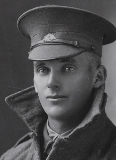
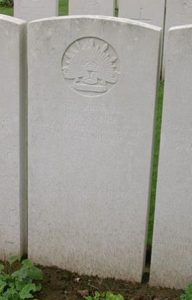
Joseph Young, Private, 20547, South Wales Borderers. Joseph was the son of Benjamin Young and Ann Young (nee Thomas), of 20, Gantra Row, Ebbw Vale. He worked as a collier prior to enlisting at Ebbw Vale into the 10th Battalion, South Wales Borderers soon after the outbreak of war. The battalion was at Colwyn Bay attached to the 43rd (Welsh) Division. The Division trained in North Wales before moving to Winchester in the summer of 1915, where the formation became renumbered 113 Brigade, 38th (Welsh) Division. The Division began moving to France on 2 December 1915 and moved to the Nursery Sector near Fleurbaix for trench initiation alongside the Guards Division. The Division then held a sector of the line near Cuinchy before marching south to the Somme sector in June 1916 to take part in the assault on Mametz Wood. The first attack on the wood was launched on a two-battalion front on 7 July, but failed, and the Divisional Commander, Sir Ivor Philipps, was replaced before the Division attacked again on a two Brigade front on 10 July 1916. After two days of ferocious hand-to-hand fighting, the wood was cleared up to its northern edge, before the battered Division was relieved. It then took over a section of the front at Hébuterne before moving to the Ypres Salient and taking over the Canal Bank sector at Boesinghe. The infantry battalions of the Division then began carrying out the normal pattern of rotation in the trenches, four days in the front, four in support and four in reserve, whilst also working on trench improvement, digging new trenches, and carrying out regular patrols and trench raids. On 31 July 1917 the Division launched its famous assault on the Pilckem Ridge, capturing Iron Cross and reaching its objective of the Steenbeek, then played a supporting role in the Battle of Langemarck. Joseph had by now been transferred to the 2nd Battalion, South Wales Borderers, which was also at Ypres, attached to 87 Brigade, 29th Division. The Division relieved the 38th Division in the line to take part in the continued offensive on Langemarck. On the night of 14-15 August, the 2nd SWB moved into the line facing Langemarck, ready to launch another offensive. On the following day the battalion reconnoitred the ground in front of them, and laid white tapes in No Man’s Land, to guide the attacking troops, and at dawn on 16 August 1917 the 2nd SWB launched an attack on Langemarck. Joseph was killed in action during the assault that day. The 20-year-old has no known grave and is commemorated on the Tyne Cot Memorial, Belgium.
